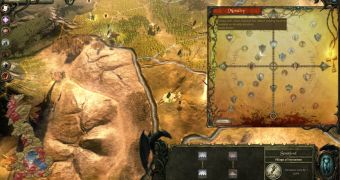When I was a younger man, I was fascinated by any classification system that could tell something about a situation by using two axis and carefully chosen data points, and I suspect that some of that fascination is seeping in and makes me love the character alignment system in King Arthur II more than I should.
On the surface, it is all very simple: depending on in-game actions, mostly linked to the choices in the text adventures bits of the game, the protagonist of the game, son of King Arthur, is graded on two axis.
The first one goes from Tyrant to Righteous and the other one leads from the Old Gods to Christianity, and they create four quadrants that then grand the player a host of bonuses, which tend to become more attractive and interesting the more committed to one of the values a player becomes.
Basically King Arthur II – The Role-Playing Wargame provides a lot of incentive for players to commit to one position and then stick with it for the duration of the game, instead of simply min-maxing and choosing the most advantageous answer during each text adventure.
A Moral and Christian king can get access to Seraphims as long as he promotes the religion with all his actions and never raises one hand against his citizens, making it easier to hang on to his ideas instead of being tempted by that 1000 gold he could get by raising a bigger levy on one province.
The problem is that at times the game feels like it is taking the path dependency a little bit too far and restricts what a player can do.
For the dedicated player the four quadrants basically create four rather different experiences which necessitate four runs through the game to complete, although I find that playing Righteous and Christian and Old Gods and Tyrannical are the best after playing through the first King Arthur II.

 14 DAY TRIAL //
14 DAY TRIAL //